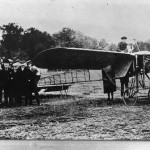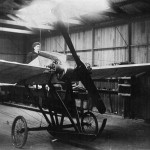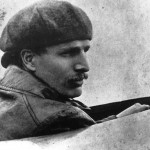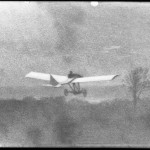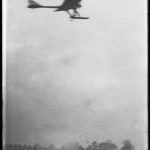If asked who the famous pioneers of early aviation were the obvious answer would be the Wright brothers. You may not know, however, that Stirlingshire and Scotland had its very own aviation heroes, the Barnwell Brothers.
Frank Barnwell (b. 1880) and Harold Barnwell (b. 1878) were born in Lewisham, London, but soon moved to Elcho House in Balfron in 1882. Their father, Richard Barnwell was Managing Director of Fairfield Shipbuilding and Engineering Co., in Govan. Whilst Frank would obtain a degree from the University of Glasgow in Naval Architecture and Engineering and Harold would be educated at Fettes College, Edinburgh, aviation was the real interest of the brothers.
There are suggestions that Frank and Harold built their first glider in 1905 in the backyard of their house in Balfron but this has never been confirmed. There was a definite interest in aviation, however, which would be further sparked by Frank Barnwell’s work in America. After graduating, Frank Barnwell spent a year in America working for an American Shipbuilding Company. It is rumoured that it was here he met the famous Wright brothers.
While Frank was in America, in 1907 Harold and his other brother Archibald purchased the business and premises of John Simpson and Co. of Causewayhead. It was here they formed the Grampian Engineering and Motor Company. It would be on these premises, and on Frank’s return, that the brothers would build and finish their first aircraft in 1908.
Their first creation, along with the several attempts that followed, would all have the same problem: they couldn’t get off the ground. Their first success, however, came in 1909. The brothers had designed a large canard biplane which was then constructed by their Grampian Engineering and Motor Company. It was on the fields of Causewayhead on the 8th July 1909 that Harold achieved the pioneering moment. The aircraft took off, reached an altitude of 13ft and travelled eighty yards before being damaged on its landing. The Barnwell brothers had achieved Scotland’s first powered flight.
Repair works on the machine resulted in the completion of another test flight in 1909 during which they reached a height of 25ft. Sadly, afterwards the plane was damaged beyond repair. In 1911, the brothers designed their last machine, and built six of them. Piloted by Harold, this plane made the longest flight in Scotland to that date travelling for a mile, a wonderful achievement for this time. The success of the brothers were then recognised by the Scottish Aeronautical Society with an award of £50.
After 1911, the paths of the two brothers diverged. Harold continued to fly, design and test aircraft. Tragically, in 1917, he was involved in fatal crash whilst testing the Vickers ‘Vampire’ aircraft. There had been suggestions that Harold was ill before flying and had fainted whilst piloting the aircraft.
Frank Barnwell, like his brother, continued to fly, design and build aircraft. Two of his most notable achievements were the design of the Bristol F2 Fighter during the First World War, and the Bristol Blenheim which served during The Second World War. Frank was Head Designer of the Bristol Aeroplane Company that manufactured the planes. Like his brother, Frank was involved in a fatal crash whilst testing his own aircraft in 1938.
The life and work of the brothers was recently commemorated in 2005 with the unveiling of a sculpture commissioned to celebrate the brother’s famous flight. The statue is located A907 Alloa Road/Causewayhead roundabout near the site of the fields and workshops where the famous test flights were carried out.
